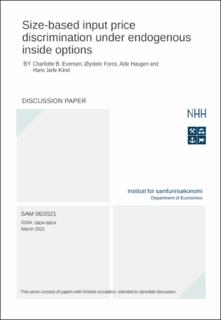| dc.contributor.author | Evensen, Charlotte B. | |
| dc.contributor.author | Foros, Øystein | |
| dc.contributor.author | Haugen, Atle | |
| dc.contributor.author | Kind, Hans Jarle | |
| dc.date.accessioned | 2021-03-11T07:46:26Z | |
| dc.date.available | 2021-03-11T07:46:26Z | |
| dc.date.issued | 2021-03 | |
| dc.identifier.issn | 0804-6824 | |
| dc.identifier.uri | https://hdl.handle.net/11250/2732717 | |
| dc.description.abstract | Individual retailers may choose to invest in a substitute to a dominant supplier’s products (inside option) as a way of improving its position towards the supplier. Given that a large retailer has stronger investment incentives than a smaller rival, the large retailer may obtain a selective rebate (size-based price discrimination). Yet, we often observe that suppliers do not price discriminate between retailers that differ in size. Why is this so? We argue that the explanation may be related to the competitive pressure among the retailers. The more fiercely the retailers compete, the more each retailer cares about its relative input prices. Other things equal, this implies that the retailers will invest more in the substitute the greater the competitive pressure. We show that if the competitive pressure is sufficiently strong, the supplier can profitably incentivize the retailer to reduce its investments in substitutes by committing to charge a uniform input price. Furthermore, we show that under uniform input pricing, the large retailer may induce smaller rivals to exit the market by strategically underinvesting in inside options. | en_US |
| dc.language.iso | eng | en_US |
| dc.relation.ispartofseries | DP SAM;06/2021 | |
| dc.subject | Input price discrimination, size asymmetries, retail competition, inside options, entry, exit | en_US |
| dc.title | Size-based input price discrimination under endogenous inside options | en_US |
| dc.type | Working paper | en_US |
| dc.subject.nsi | Samfunnsvitenskap | en_US |
| dc.source.pagenumber | 36 | en_US |
